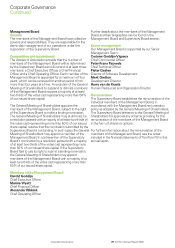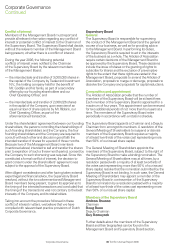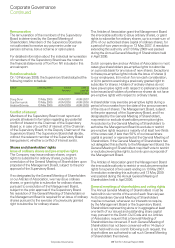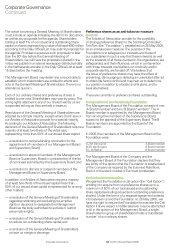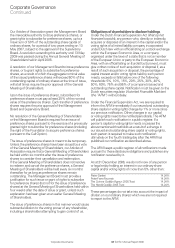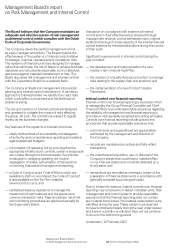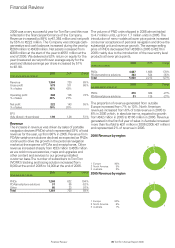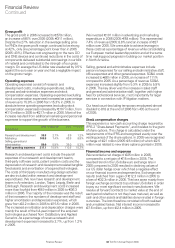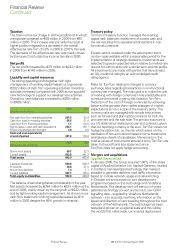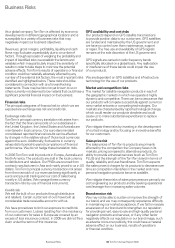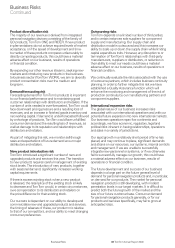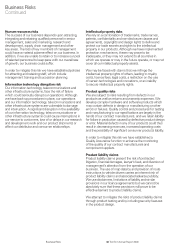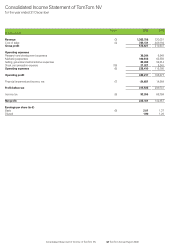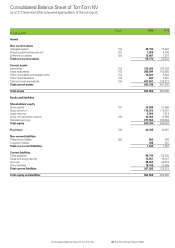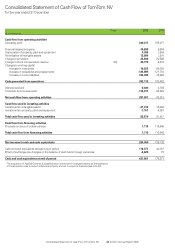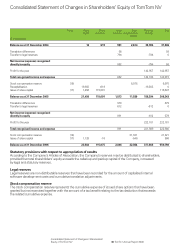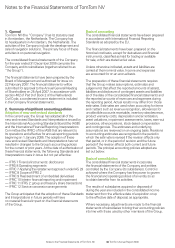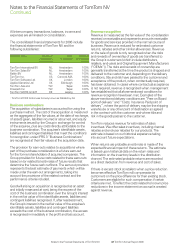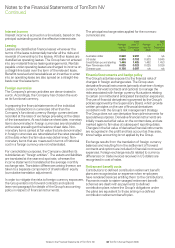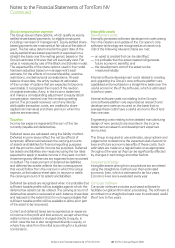TomTom 2006 Annual Report Download - page 41
Download and view the complete annual report
Please find page 41 of the 2006 TomTom annual report below. You can navigate through the pages in the report by either clicking on the pages listed below, or by using the keyword search tool below to find specific information within the annual report.39 TomTom Annual Report 2006Business Risks
Business Risks
Continued
Product diversification risk
The majority of our revenue is derived from integrated
personal navigation devices consisting of the family of
GO products, TomTom ONE and RIDER. If new product
implementations do not achieve required levels of market
acceptance, or if the speed of development and time-
to-market of these products compares unfavourably to
directly competing products, this could have a material
adverse effect on our business, results of operations
or financial condition.
By expanding our other revenue streams, seeking new
markets and introducing new products in the business-
to-business sector (TomTom WORK), we aim to diversify
product concentration risks over the medium and
long-term.
Demand forecasting risk
Forecasting demand for TomTom’s products is important
to our financial performance and to maintaining good
customer relationships with distributors and retailers. If the
number of units needed is over-forecasted, TomTom could
face downward pricing pressure and a resulting loss of
revenues, and an increase in finished goods inventory and
net working capital. If demand is under-forecasted followed
by a shortage of products, TomTom could face unfulfilled
consumer demand and the resulting loss of revenues, as
well as damage to its reputation and relationships with
distributors and retailers.
As part of mitigating this risk, we monitor sell-through
rates and expectations of future demand at our major
distributors and retailers.
New product introduction risk
TomTom introduced a significant number of new and
upgraded products and services this year. The transition
to new products requires careful management of existing
stock levels. The introduction of new products, together
with seasonal demand, significantly increases working
capital requirements.
If there is excess existing stock when a new product
is released, the retail price of the existing stock is likely
to decrease and TomTom would, in certain circumstances,
owe compensation to its distributors and retailers on
the price difference for their existing stock.
Our success is dependent on our ability to develop and
commercialise new and upgraded products and services,
the timing of releases of these, our product mix relative
to that of our competitors, and our ability to meet changing
consumer preferences.
Outsourcing risks
TomTom depends on a limited number of third parties,
and in certain instances sole suppliers for component
supply and manufacturing. Our supply chain and
distribution model is outsourced and this increases our
ability to scale up or down the supply chain while limiting
capital expenditure risks. However, any disruption to or
termination of TomTom’s relationships with third-party
manufacturers, suppliers or distributors, or reduction in
their ability to meet our needs could have a material
adverse effect on our business, results of operations or
financial condition.
We continually evaluate the risks associated with the use
of outsource partners, which includes business continuity
planning. In order to further mitigate this risk we have
established a Quality Assurance function which will
enhance the monitoring and management of the risk of
production continuity by our manufacturing partners and
component suppliers.
International expansion risks
The global nature of our business increases risks
associated with our international operations and with our
potential future expansion into new international markets.
Our business operations span five continents and
accordingly, we face economic, regulatory, legal and
political risks inherent in having relationships, operations
and sales in a variety of jurisdictions.
Our rapid growth in a relatively short period of time has
placed, and may continue to place, significant demands
and strains on our resources, our systems, internal controls
and management. If we are unable to successfully
integrate new personnel or systems, or if we otherwise
fail to successfully manage our growth, this could have
a material adverse effect on our business, results of
operations or financial condition.
The future development and success of our business
depends in a large part on the future general level of
demand for personal navigation products and, in particular,
on demand for our products. The market for personal
navigation products is still developing, with modest
penetration levels in our target markets. It is difficult to
predict both the future growth of the market and the
size of our future customer base. Consumer demand
for personal navigation products generally, or for our
products and services specifically, may fail to grow at
anticipated rates.


